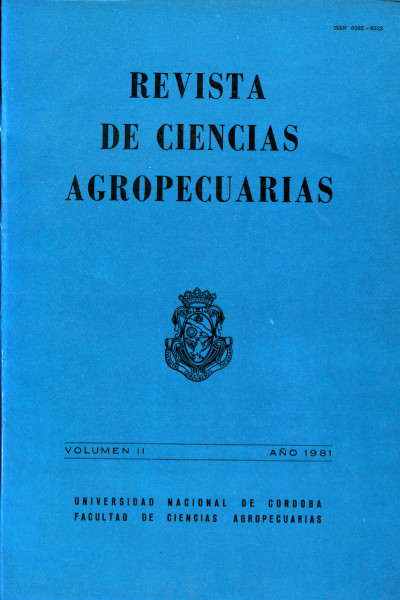Selectivity of differents traps for insect capture. I. Scarabaeinae
Main Article Content
Abstract
Article Details
How to Cite
References
BALOG, Ja nos. 1958. Lebensgemeinschaften der Landtiere, Akademie-Verlag Berlin. 560 pp.
BERNSTEIN, C. et al. 1973. Fluctuaciones de la densidad relativa de adultos de una paga de alfalfa, Colias lesbia (F,.) y su relación con algunos factores ambientales. Ecología, 1 (1) : 19-24. Asoc. Arg. Ecol.
BLACKWELDER, R. S.: Checklist of the Coleopterous insects of Mexico, Central America. the West Indies and South America. Bull. U.S. nat. Mus. 185 (2): 197-265.
BREWER, M. y L. VARAS. 1973. Contribución al conocimiento de la sistemática y comportamiento de los gorgojos (Col. urculionidae), perjudiciales para la alfalfa. Rev. Inv. Agr., Ser. 5, Pat . Veg. 10 (1); 55-97. Bs. As.
BURRIL, A. C. 1918. New economic pes tof red clover. J. econ. Ent. 11 421-424.
DI PACE, María J. et al. 1973. Métodos de estimación de densidades para Colias lesbia (F.) y otros artrópodos de los alfalfares. Ecología 1 (1) 11-17. Asoc. Arg. Ecol.
ESSIG, E. O. 1947. College Entomology. The Macmillan Co. N.Y. 899 pp.
FENTON, F. A. 1959. The effect of several insecticides on the total arthropod population in alfalfa. J. econ. Ent. 52: 428-432. 1959.
FOLSOM, J. W. 1909. The insect pest of clover and alfalfa. Univ. Ill, agrie. Exp. Stn. Bull. 134: 113-197.
JANSEN, D. A. y SHOENER, T. W. Differences in insect abundance and divers: tes during a tropical dry season. Ecology, 49: 69-110. Nat. Hist. Mus. Ed. Managing. Crawsord G. Jackson. San Diego. Calif.
JANSEN, D. A. y C. POND. 1975. A comparison, by sweep sampling of the arthropod fauna of secondary vegetation in Michigan. England and Costa Rica. Trans, R. ent. Soc. Lond. 127 (1) : 33-50, 4 figs.
MAXUELL, A. E. 1966. Análisis estadístico de datos cualitativos. UTEHA. México.
SHEPARD, M., G. R. CARNER y S. G. TURNIPSED. 1974. A comparison of three sampling method for Arthropods in soybeans. Env. Ent., 3(2): 227-232. Ent. Soc. Am.
SMITH, J. W., E. A. STADELBACHER y C. W.. GANTT, 1976. A comparison of techniques for sampling beneficial arthropod populations associated with cotton. Env. Ent. 5 (3): 435-444. Ent. Soc. Am,
SOUTHWOOD. T.R.E. 1960. Ecological methrods with particular reference to the study of insect populations. 391 pp. Met. CO. Lmt., 11 New Fetter Lane Lond.





